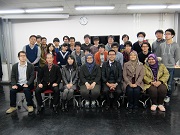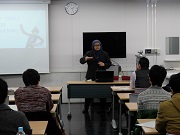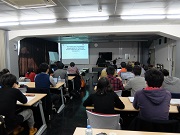〜科学技術の発展を支える人材育成〜
JICAでは東南アジア域内の産業の持続的発展のために、2001年よりアセアン工学系高等教育ネットワーク(AUN/SEED-Net)のもと、ASEAN10カ国に26校のメンバー大学、日本に14校の支援大学を指定し、工学系高等教育分野の人材育成支援を行っています。具体的には、大学院レベルの学位取得プログラムや各種共同研究プログラムのほか、産業界との連携促進活動、加盟大学間の人的・学術的交流の促進(ネットワークの構築・強化)等の取り組みを行っています。学位取得プログラムでは、これまでに648名が修士号、443名が博士号取得プログラムで研究してきました(2015年3月現在)。
学位取得プログラムの一つであるサンドイッチ博士プログラムは、メンバー大学の若手教員・若手教員候補者にASEANのメンバー大学における3年間の博士課程での修学の機会を提供するもので、3年間の課程のうち一部期間(最長8か月)本邦支援大学の共同指導教員の研究室にて研究指導を受けることができる仕組みとなっています。博士課程修了後は出身大学に戻り教員として勤務し、出身大学及び自国、さらには地域の発展に貢献することが期待されています。

【キャプション】指導教員及び研究室の同僚達と(前列中央)Diana-san with faculty members and her colleagues in the laboratory team. [She sits in the middle of the front row.]
今回はこのSUN/SEED-Netサンドイッチ博士プログラムのもとマレーシアから来日したディアナさんを紹介します。ディアナさんはマレーシア工科大学土木工学科の博士課程に在籍し、2015年9月末に来日し、2016年4月まで約7か月間、早稲田大学で研究をしています。活発で人懐こいディアナさんは、指導教員の研究室の仲間達にすぐに溶け込み、また短い滞在期間にも関わらず綿密に準備してきた研究計画に沿って確かな成果を上げることができました。
彼女の研究テーマは、「環境に優しいコンクリート混和剤としてのセルロースナノクリスタルの利用可能性」です。農業廃棄物の多いマレーシアの状況に着目し、中でもパーム油産業から大量に排出される廃棄物であるアブラヤシの幹から採取した物質(セルロースナノクリスタル)を建設材料のコンクリートに混ぜ、再生可能でより軽く強靭で断熱性にも優れたコンクリートを開発しようとするものです。
植物繊維及び植物細胞壁の主成分が「セルロース」であり、セルロースをほどいて再構成した繊維材料がセルロースナノファイバー(CNF)、そしてさらにCNFを高濃度の硫酸で処理して得るセルロース純度の高い結晶素材が、セルロースナノクリスタル(CNC)だそうです。これらCNFとCNCは総称してナノセルロースと呼ばれ、軽くて強く熱にも強いという特徴と再生可能であることから、新素材として近年世界で注目されています。
マレーシアで建設材料として使われている従来のコンクリートは、重くて輸送が困難、高層ビルへの利用には耐えない、暑い気候で必要とされるだけの断熱効果がない、再利用が困難で環境負荷が高い等の問題を抱えており、セルロースナノクリスタルがこれらの問題を解決してくれる可能性があるのです。

参加者からの質問に答えるディアナさん Diana-san, answering a question from a participant.

早稲田大学でのシンポジムの様子 Joint Symposium at Waseda University
ディアナさんは日本滞在中、粉体工学会や化学工学会からの依頼を受けて講演を行いました。また、2016年3月1日に早稲田大学で開催されたマレーシア工科大学との共同シンポジウムでは、ディアナさんによる研究発表のほか、マレーシア工科大学土木工学部環境工学科のファディル准教授、シャズウィン上級講師からはココナッツやアブラヤシの廃棄物を利用した河川浄化についての研究や農業資源の再利用に関するASEAN諸国の大学との共同研究等が紹介され、早稲田大学創造理工学部環境資源工学科の所教授、大和田教授からは、酸性鉱山廃水浄化のための金属選別新技術や金属廃棄物選別のための破砕・粉砕研究が紹介され、参加した学生達も含めて活発な意見交換が行われました。シンポジウムの終りにファディル准教授はマレーシアと日本の研究テーマの違いに触れ、大切なことは『それぞれの社会で何が必要とされているか』を考え『それぞれの環境で入手できる物を利用』して技術革新をしていくことだと熱く語り、今後も引き続き早稲田大学との交流を深め互いに学び合っていきたいと結びました。
所教授とディアナさんは今回の滞在中に発展的な研究への糸口を見いだし、今後の連携に意欲を示しています。具体的には所教授の専門である「固体分析と固体の化学的形態の把握」で得た化学的な知見を「コンクリート強度向上」に対して適用すれば、これまで明らかになってこなかった様々な物性変化の原因が突き止められるのではないか、ということです。所教授とディアナさんにより新しい発見がされるかもしれません。今年の夏には所教授が早稲田大学の学生を連れてマレーシア工科大学を訪問し学生にインターンシップの経験をさせると共に、今後の具体的な研究連携の話し合いをする予定だとのことです。博士号を取得後も、引き続き自国で環境と土木工学分野での研究を深めていく予定のディアナさん。マレーシア、ASEAN諸国さらに日本の間の架橋となり、地域全体の学術的交流を牽引してくれることでしょう。
JICA東京 人間開発課
〜〜〜〜〜〜〜〜〜〜〜〜〜〜〜〜〜〜〜〜〜〜〜〜〜〜〜〜〜〜〜〜〜
【英文抄訳】
( For Sustainable Development of ASEAN Countries )
〜Human Resource Development for Technology Advancement〜
AUN-SEED-Net was established in 2001 and consists of 26 leading Member Universities from 10 ASEAN countries with the support of 14 leading Japanese Supporting Universities. JICA support this project and this network conducts various academic activities with its aim that Southeast Asia and Japan will be developed sustainably through the development of innovative and highly skilled human resources in the engineering field.
Please see the AUN/SEED-Net Homepage below for more information.
This time, we would like to introduce Dianah-san who came to Japan from Malaysia through Sandwich Doctor Program. Dianah-san, a doctor course student at Faculty of Civil Engineering of Malaysia Technology University, came to Japan in late September, 2015 and she is carrying out her research at Waseda University until April, 2016. As she is active and friendly, she has right away fit into a circle of laboratory. Despite the short stay period, she was able to produce a concrete result following the detailed plan she had been prepared.
Her research theme is “Usability of cellulose nanocrystals as environment-friendly admixture for cement composites”. Considering the abundance of agro-wastes in Malaysia, she tries to add cellulose nanocrystal which is taken from the trunk of palm oil waste into cement composite to develop new construction material which is lightweight, strong, good thermal insulation effect and recyclable.
Cellulose is the main component of plant fiber and plant cell wall. From cellulose, cellulose nanofiber (CNF) is produced by untangling cellulose and recompose them. Cellulose nanocrystal is a crystal material with high grade cellulose produced by processing CNF with highly concentrated sulfuric acid. These CNF and CNC both are called Nano cellulose and recently gathering attention in the world as new material for its lightness, strength, heat-resisting property and recyclability.
The cement composite conventionally used in Malaysia as construction material has drawbacks such as: transport difficulties for its weight, inappropriateness for high rise building, low insulation effect for hot weather and environmental load. Cellulose nanocrystal may have solution for all those problems.
During her stay in Japan, she made presentations on her research responding requests from Society of Powder Technology and Society of Chemical Engineers. At the Joint Symposium held at Waseda University on March 1st, 2016, in addition to her presentation, Assoc. Prof. Fadhil and Senior Lecturer Shazwin from UTM presented “research on river cleansing using coconut and oil palm waste”, “joint research with other ASEAN universities” and so on. Prof. Tokoro and Prof. Oowada from Waseda University presented “new separation technology for purification of acid mine drainage” and “fragmentation and powdering technology for separation of metal waste”. At the end of the Symposium, after the active discussion including the participated students, Assoc. Prof Fadhil mentioning the difference of the research theme between Malaysia and Japan, said enthusiastically the important thing is to think “the needs of your society” and seek for technological innovation utilizing “the material you can find in your environment” and concluded that UTM would like to further deepen the interaction with Waseda University and to learn each other from this relationship.
Prof. Tokoro and Dianah-san, during her stay this time, have found the clue for further constructive research and willing to continue their collaboration. After acquiring Doctor Degree, Dianah-san will continue her research in the field of environment and civil engineering in her country. She will be the cross bridge between Malaysia and ASEAN countries and also with Japan. We expect she will lead the academic interaction in the whole region in the future.
Human Development Division, TIC